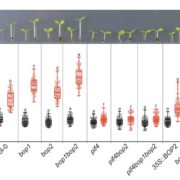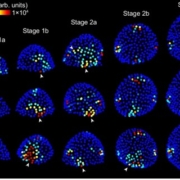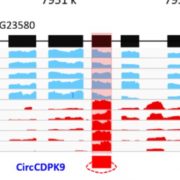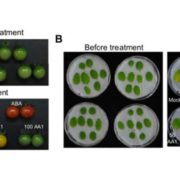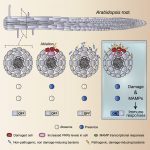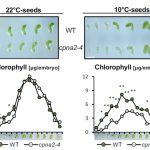HY5 interacts with and recruits HDA9 to negatively regulate autophagy (Mol. Plant)
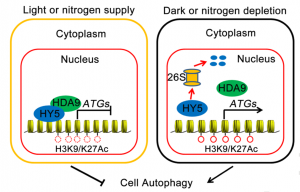 Plants activate autophagy, a cellular recycling process, to recycle useful nutrients or remove harmful items, helping them to withstand harsh conditions. Recently, Yang et al. found that HY5 is a hub connecting the light signaling and autophagy pathways. Under replete conditions (e.g., light and nitrogen-sufficient), the transcription factor HY5 associates with HDA9 and recruits it to autophagy-related genes (ATGs) to repress their expression via histone deacetylation. Under darkness or nitrogen-deficient conditions, HY5 is degraded through the 26s proteasome, HDA9 dissociates from ATGs, and they are derepressed via histone acetylation, thereby activating autophagy. This study demonstrates a previously unknown mechanism of how HY5 associates with histone modification machinery to modulate plant autophagy, and also describes how plants employ different gene expression patterns in response to a fluctuating environment. (Summary by Nanxun Qin) Mol. Plant 10.1016/j.molp.2020.02.011
Plants activate autophagy, a cellular recycling process, to recycle useful nutrients or remove harmful items, helping them to withstand harsh conditions. Recently, Yang et al. found that HY5 is a hub connecting the light signaling and autophagy pathways. Under replete conditions (e.g., light and nitrogen-sufficient), the transcription factor HY5 associates with HDA9 and recruits it to autophagy-related genes (ATGs) to repress their expression via histone deacetylation. Under darkness or nitrogen-deficient conditions, HY5 is degraded through the 26s proteasome, HDA9 dissociates from ATGs, and they are derepressed via histone acetylation, thereby activating autophagy. This study demonstrates a previously unknown mechanism of how HY5 associates with histone modification machinery to modulate plant autophagy, and also describes how plants employ different gene expression patterns in response to a fluctuating environment. (Summary by Nanxun Qin) Mol. Plant 10.1016/j.molp.2020.02.011
[altmetric doi=”10.1016/j.molp.2020.02.011″ details=”right” float=”right”]


